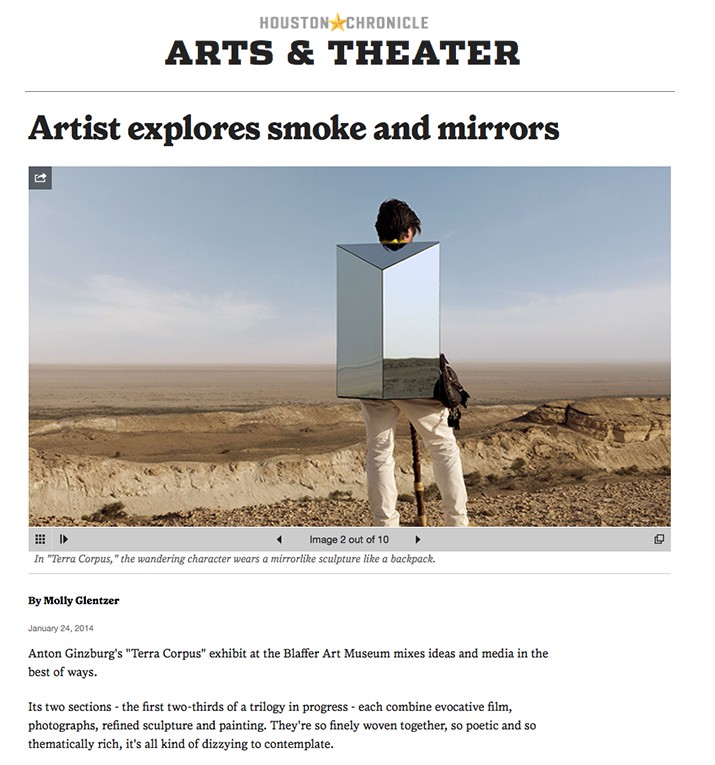Artist explores smoke and mirrors
by Molly Gletzner
https://www.houstonchronicle.com/entertainment/arts-theater/article/Artists-explores-smoke-and-mirrors-5172998.php

Anton Ginzburg's "Terra Corpus" exhibit at the Blaffer Art Museum mixes ideas and media in the best of ways.
Its two sections - the first two-thirds of a trilogy in progress - each combine evocative film, photographs, refined sculpture and painting. They're so finely woven together, so poetic and so thematically rich, it's all kind of dizzying to contemplate.
"The whole trilogy is an exploration of the 20th century; the idea of creating a utopia then unmaking it," Ginzburg said during a tour of the exhibit.
He appears in the films and photographs as a roving character who seems to be part geographer, part archaeologist, part spirit guide. He's searching for Hyperborea, a mythical place of pure bliss discussed by the ancient Greeks and conjured on maps since the 16th century.
Many early writers and cartographers located Hyperborea at the top of the world. That's where Ginzburg started for "At the Back of the North Wind," the exhibit's first section, which was created for the 54th Venice Biennale in 2011.
The anchor, a 45-minute film, follows the character from primordial virgin forests near Astoria, Ore., to an empty castle in St. Petersburg, Russia, and the ruins of former Soviet Gulag compounds near the remote White Sea.
Thoughts of an underworld emerge in part two, "Walking the Sea," which is premiering at the Blaffer. For this section, Ginzburg trekked the dried-up Aral Sea between Kazakhstan and Uzbekistan, a UNESCO site considered one of the world's worst water-management disasters.
A native of St. Petersburg who's lived in New York since the 1990s, Ginzburg wanted to engage Eurasian landscapes as a nod to earthwork masters of the American West. Only he didn't want to actually change the environment, so he created "temporal interventions."
Most dramatic is the red smoke he employs in "At the Back of the North Wind," bringing a painterly, chiaroscuro effect to the film as it explodes then dissipates across snowy environments.
In the 30-minute looped film that anchors "Walking the Sea," the character walks from morning to evening across what's now a grassy, salty landscape. He passes grazing camels and locals who are removing things from an abandoned secret military compound (once isolated on an island) to use as building materials.
"The footage is quite unique," Ginzburg said. "There's only one month you can access this territory, May. Then it becomes super hot, and before that there's too much moisture."
The "Walking the Sea" character comes straight from Gustav Courbet's 1854 painting, "Bonjour M. Courbet," except that his backpack is a mirrored structure.
If Ginzburg paid homage to the land art of Robert Smithson in the first film, the second takes cues from the mirrored art of Dan Graham. And they're opposites: The smoke of the first film obscures, the mirror reflects. Sometimes it's covered with a black cloth, like a large-format camera.
Exposing his vigorous research, Ginzburg has hung images of Courbet's painting and other inspirations on one wall. They're printed on black paper so they look like negatives that might have come from such a camera.
Ginzburg embedded a more complex mirrored structure in the wall that separates the exhibit's two sections. "No matter where you are, you will see yourself," he said.
Blaffer director Claudia Schmuckli pointed out how the "North Wind" section has a vertical serge, with reliefs hung high on the gallery walls; while "Walking the Sea" has a spiral, horizontal sensibility, as if it was spun into place by a whirling dervish.
There's material significance in a cotton tapestry that looks like a film strip of aerial images of the shrinking sea, which once covered 26,000 miles. Its feeder rivers were diverted in the 1960s to develop a cotton industry in the area.
A monumental sculpture, "The Sea Harp," inspired by a Henry David Thoreau essay, dominates this gallery. It's built from elements one might find in the Aral Sea now, including long slabs of concrete. As visitors approach, the sculpture emits wind sounds Ginzburg gathered from the sites he visited.
Intrepid visitors will find much to contemplate in both sections. I love the beautiful plaster reliefs: Some were created from topographic maps of the northern locations Ginzburg visited; others have geometric shapes based on wind movement and textile patterns.
Ginzburg's beautiful sculptures include a pair of black-and-white marble totems that depict an owl and his shadow; and the 13-foot "Ashnest," which is like a futuristic relic, incorporating actual mammoth tusks.
The artist said he designed the spaces to create tension between the emotional palette of the mediums, their forms; and their relationship to the narrative, the film.
"Just walking through the exhibition is part of the experience," he said.

